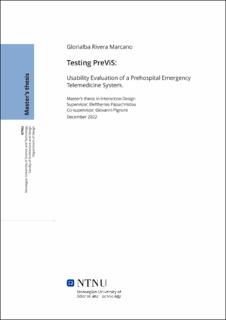| dc.description.abstract | Abstract
The Norwegian Health Center Sykehuset Innlandet is currently exploring the potential of integrating live video conference capability into emergency response/paramedic activities through a system called PreViS. First-hand research revealed that, even though the project is in the soft-launching stage within a growing number of paramedic stations in the region, no usability studies have been made on it. Because of this, the current research was dedicated to designing, conducting, and analyzing such studies on the device.
The main research questions were:
Q1: Can the system help make examinations more accurate in comparison to the control group?
Q2: Is the usability of the system acceptable for its use in prehospital emergencies?
The principal method used to answer Q1 was that of medical simulations. Two groups of paramedics —with 3 participants each—, conducted the same simulated emergency scenario. The control group followed the standard operating procedures expected of their practice in Norway. The intervention group used the PreViS headset instead. The data from this simulation was sifted through a performance evaluation framework created for this purpose.
To answer Q2, a usability inspection was performed on a) behaviors observed during the simulation and, b) the interfaces of the headsets (including GUI, and voice-command / navigation structure). The results of this evaluation were compared against usability heuristics.
After these methods were implemented, the results were the following:
For Q1, it was found that the simulations in the intervention group performed more accurately than those in the control group, the latter having been marred by errors and consequent harmful interventions. The visual component of the headset, in particular, helped make the examination more accurate, bypassing the interpretation of the interloper, and providing an almost first-hand point of view for the Remote Healthcare Professional (RHP).
In the case of Q2, the findings were less positive. Several heuristic violations and system errors were found on the inspection. The most notable of them was the presence of a technical failure which made the device respond randomly to voice commands when no such action had been taken. The appearance of these was very disruptive, with 8 random activations appearing in one simulation alone. Other findings were related to a subpar heuristic implementation of the GUI, navigational elements, and system language and nomenclature.
The conclusion of this research question is that —in the opinion of the author—, the current iteration of the system is suffering from too many usability violations to be ready for launching, especially for such a complex hectic environment as the emergency prehospital practice. An overhauling of the software of the device is necessary for it to be able to fulfill usability principles.
Q1 was answered positively, while Q2 was answered negatively. These results are however not incompatible. If the results of this research are found to be generalizable when submitted to larger, more diverse sampling, it would mean that the idea of PreViS has a good proof of concept, as it would make examinations more accurate, and reduce the potential of patient harm. The flaws found on PreViS were all rooted in the imperfections of the device itself, not in the concept. Even if the issues found on the evaluation cannot be amended in future iterations, there is always potential that the idea of PreViS can find a more suitable home on a different device. The rise of wearables, AR, and body-mounted cameras make this prospect a very attainable one. | |
